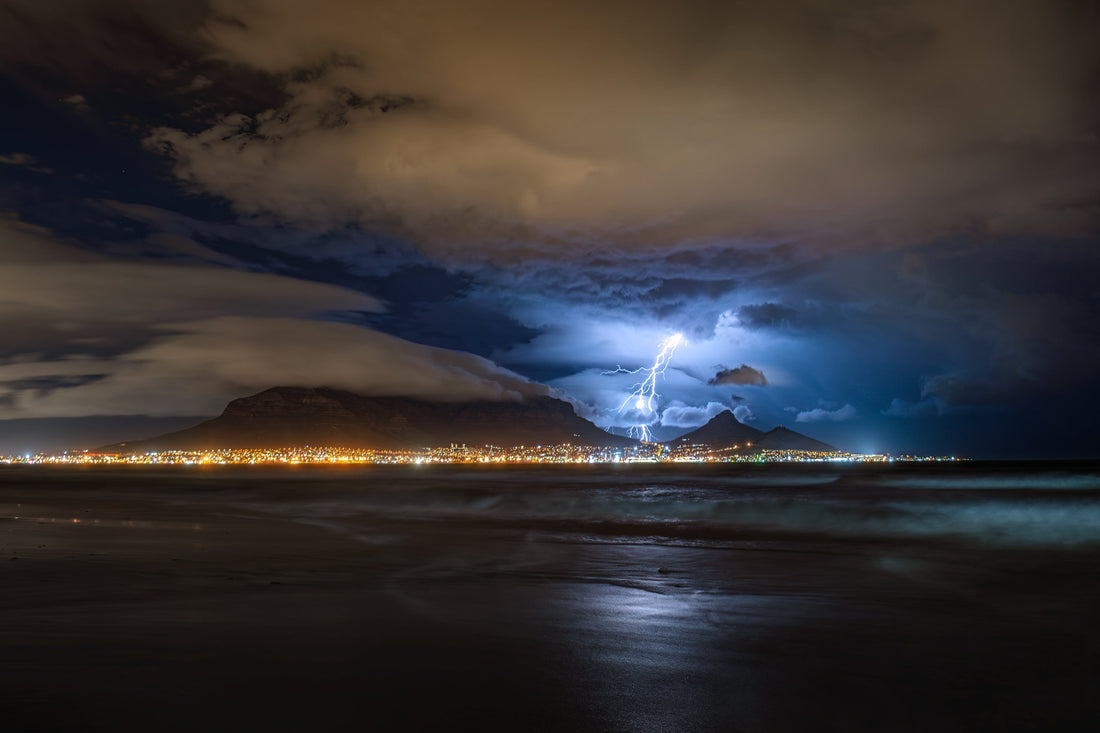
Chasing Lightning Over Table Mountain – A Once-in-a-Lifetime Experience
Kyle GoetschShare
There are certain moments in photography that stick with you forever, when the elements align in ways so rare and unpredictable that even attempting to capture them feels like an act of defiance against nature itself. One of those moments for me was in January 2020, when an incredibly rare lightning storm raged over Table Mountain. Cape Town, known for its Mediterranean climate, sees very little thunderstorm activity, and to witness lightning striking above its most iconic landmark was a once-in-a-lifetime opportunity.

A Rare Phenomenon in Cape Town
Unlike Johannesburg and other parts of South Africa that experience frequent summer thunderstorms, Cape Town’s climate is largely influenced by the cold Atlantic Ocean, which suppresses the convective activity needed for thunderstorms. The presence of the powerful Cape Doctor (a strong south-easterly wind) also keeps conditions dry and stable. So, when a rare convergence of warm, humid air and an approaching frontal system triggered a lightning storm directly over Table Mountain, it was an event unlike anything I had seen before.
As soon as I saw the first bolts flashing in the distance, I knew I had to act fast. Lightning in Cape Town is fleeting, this wasn’t a storm that would rage for hours, but rather one that could vanish as quickly as it had arrived. I grabbed my gear and headed to Bloubergstrand, hoping to capture the ultimate shot: a lightning bolt striking above Table Mountain with the city lights below.
Battling the Elements: Shooting in Gale-Force Winds
If capturing lightning wasn’t already a challenge, the conditions that night made it nearly impossible. Gale-force winds ripped across the beach, sending sand flying in every direction. Standing still was difficult enough, keeping a camera steady on a tripod felt like a battle against an invisible force. Even my sturdy tripod, weighed down with my camera bag, was shaking under the onslaught.
Focusing was another nightmare. With the wind howling and the sandstorm reducing visibility, achieving sharp exposures was nearly impossible. I had to wipe my lens constantly to clear away the fine layer of sea spray that was building up. Very long exposures were out of the question—the wind vibrations would introduce motion blur. Instead, I had to work with shorter shutter speeds while still keeping my ISO as low as possible to avoid excessive noise in the shadows.
Then, in the midst of the chaos, it happened. A massive bolt arced across the sky, illuminating the clouds above Table Mountain in a way I had never seen before. I had pressed the shutter at just the right moment, capturing the electric energy of the storm as it danced above the city. The result? A shot I will never forget.

How to Photograph Lightning
Capturing lightning requires both preparation and luck. Here are some key techniques I use that can help you get the shot:
1. Use a Sturdy Tripod (and Weigh It Down)
Lightning photography requires long exposures, which means stability is critical. In strong winds, weighing down your tripod with a camera bag or using sandbags can help minimize movement.
2. Set Up with a Wide Composition
Lightning is unpredictable. Using a wide-angle lens increases your chances of catching a bolt within your frame. You can always crop in later if needed. I use a 20mm lens.
3. Use Manual Focus
Autofocus struggles in low light, especially during storms. Focus manually on a distant city light or a landmark before switching to manual focus mode to prevent your camera from hunting.
4. Adjust Your Exposure Settings
-
Shutter Speed: 5-15 seconds for distant lightning, shorter if the strikes are frequent.
-
Aperture: f/8 to f/11 to keep most of the scene in focus. Can drop to f/4 to f/5.6 if shooting at night.
-
ISO: As low as possible (ISO 100-400) to reduce noise, especially in dark conditions. You can go up to ISO 1600, but shoot very dark - a big bolt of lightning will blow out your highlights if your settings are too bright.
5. Use a Remote Shutter Release or Interval Timer
Minimize camera shake by using a remote trigger or setting your camera to take continuous long exposures. This increases your chances of capturing the perfect strike.
6. Stay Safe
No photo is worth risking your life. Always shoot from a safe distance, avoid standing in open areas, and keep an eye on weather warnings. If the storm is getting too close, it’s time to pack up.
Final Thoughts
Photographing lightning over Table Mountain was one of the most challenging yet rewarding experiences of my photography career. The combination of rare meteorological conditions, brutal winds, and sheer luck made for an unforgettable night. It was a stark reminder that some of the best shots don’t come easily, but when the moment presents itself, you have to be ready to chase it.
Cape Town may never see another lightning storm like that for years to come, but that night in January 2020 will always stand as proof that sometimes, nature gives us something truly extraordinary to capture. And as photographers, all we can do is be ready when it does.
